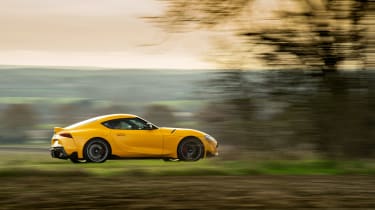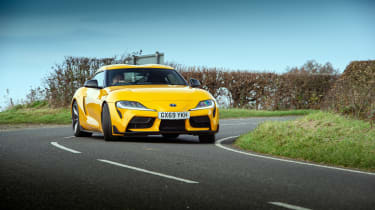Toyota GR Supra – ride and handling
Responsive, well balanced and grippy, with good traction in the dry and a decent ride, albeit lacking outright excitement
Front-engined, rear-drive, and low-slung – the Supra is the traditional sports car layout, and Toyota claims the centre of gravity is low, too. Throw in a decent hit of power to the rear wheels and you have the makings of an entertaining driver’s car, and to a degree that’s exactly what you get.
If the drivetrain feels BMW-like, then there’s definitely a different character to the chassis. It starts with the steering, which is lighter than that of equivalent BMWs, with less of that ‘gloopy’ feeling that pervades many of the German brand’s cars.
The response is good, too, and there’s fairly natural weighting as you wind on lock, but one thing missing, at least at road-going speeds, is any real information. This improves on a circuit – it’s clearly a steering set-up that responds well when there’s some load going through it – but does leave the Supra’s front end feeling slightly aloof on the road.
You won’t have to worry too much as it’s not a car short of front-end bite. You can occasionally feel the car’s weight, usually when a quick direction change is required, but there’s plenty of grip to exploit and good mid-corner balance. On dry roads at least the Supra feels progressive on the throttle, though the BMW six’s rapid build-up of torque means on greasy or wetter surfaces it’s not difficult to break traction, something the steering is quick enough to deal with.
One of the more surprising aspects of the Supra’s dynamics is its mature ride quality, which takes the edge off sharper bumps but offers plenty of control over larger undulations. The structure feels particularly stiff too, so (not unlike recent BMWs) there’s a real sense of integrity to the car, and supportive, comfortable seats and a cabin relatively well-insulated from road and wind noise makes the Supra an adept cruiser as well as an accomplished handler.
More reviews
Group tests
In-depth reviews
Long term tests
Reviews
Unfortunately when you really begin to exercise the chassis, it doesn’t respond with so much clarity, as you feel like you’re constantly having to manage the weight and momentum of the six-cylinder up front. This could be due to its mass, but also feels like there could and should be more control across the front axle. This is where the supple ride and impressive isolation shows its compromise as it feels like there's more sparkle and edge yet to be unlocked in the chassis. And when combined with the McPherson strut front suspension that generally doesn’t have the controllability of a more expensive double-wishbone set-up, it makes for a vagueness around the front end that doesn’t instil masses of confidence. This is then added to by the rear end’s sometimes snappy nature when putting power on – a natural reaction of having a relatively short wheelbase and wide stance.
The four-cylinder actually fixes some of this front-end vagueness, with less weight and taller sidewalls on the standard 18-inch wheels that make the whole car feel pointier and more agile. It’s not night and day, but with less mass to control, and less power coming out of the powertrain to worry about balancing at the rear, it makes for a more satisfying car to drive.
All we’d have asked for is an extra level of interaction – more talkative steering and a more engaging power plant and transmission. And when lined up against the Alpine A110 and Porsche 718 Cayman, those elements really matter.
'Once rolling, one of the first things that strikes you is how much more rounded the ride is and how much better the rear axle in particular copes with sharp bumps. This is in part down to the taller tyre sidewalls, and so too is the welcome slowing down of the steering response just off-centre. In the wet, fast steering and limited low-speed traction makes the 2-litre Supra require fast reactions when at the limit. In fact it seems to gain grip and traction with speed and proves remarkably poised and comfortable on a bit of opposite lock.
'So, the four-cylinder car feels better at low speed, but it too is well balanced and biddable. It feels a little less precise and engaging when pushed, but there’s decent grip and pressing the Sport button firms up the dampers usefully, gives the engine more voice and adds weight to the steering. However, there’s not much feel through the wheel to work with, and while the chassis is responsive there’s a rather elastic quality to its feel.' – John Barker, evo editor-at-large, who tested the Supra 2.0 on the road in the UK.






